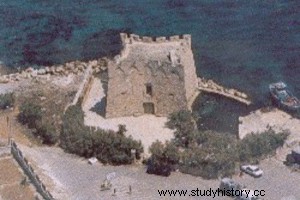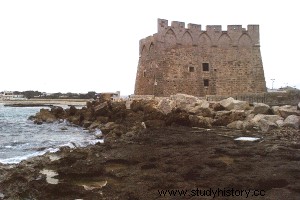
Torre Santa SAbina (Brindisi) seen from the plane
There is nothing better than combining, if and when possible, fun and culture for an unforgettable holiday:if you love history and the sea, an interesting place to visit could be Torre Santa Sabina, ancient and charming town near Brindisi.
The following article sent it to Pills of History Pierluigi Papa , founder and curator of the site brindisimedievale.it, entirely dedicated to the history of this beautiful town in Puglia:absolutely worth knowing.

Torre Santa Sabina (Brindisi)
On the provincial road that connects Brindisi with the Apulian capital, take the junction towards Carovigno to head towards a seaside resort, known in the Brindisi area and frequented during the summer, namely Torre Santa Sabina .
After parking the car, we head towards the main avenue full of bars, pub , ice cream parlors, restaurants, discopubs, stalls and rides, where on the horizon you can see the famous Tower to defend the area from attacks from the sea.
The archaeological dives that took place in the 1970s suggest that Torre Santa Sabina was a port landing site during the period of the Messapia¹ of ancient Carbina (now Carovigno) where ships arriving from the East traded their products with other Messapian cities that could have been Kaìlia (Ceglie Messapica), Orra (Oria), Brention (Brindisi), Gnathia (Egnazia) and Sturnium (Ostuni).
During these excavations, about eight thousand finds were found starting from the Mycenaean age (1,600 BC-1,000 BC) up to the Late Antiquity, but also some archaeological findings dating back to the medieval period .
According to the theories of archaeologists, the sea basin of Torre Santa Sabina was used as a port dump to throw the broken pottery during the anchoring phase or simply fallen into the sea.
The incredible discovery, according to archaeologists, is the discovery of half of a wreck² dating back to probability to a period between the end of the 3rd century AD and the beginning of the 4th century AD thanks to the findings of the ceramics, for their state of conservation.
During the period of Byzantine domination the surrounding area was surrounded by rock caves, and probably the name of Santa Sabina dates back to the cult dedicated to the Saint in these caves.
In 1226 the Teutonic Knights³ they decided to found a hospital to assist the wounded who came from the Crusades , and they also founded a chapel but no information is known about the existence of a tower.
The first evidence of the tower's existence came from the inventory by Raimondo Balzo Orsini⁴ in which it is said that it was destroyed and dates back to the 13th century.
Traces of the tower can be found in an important document from 1557 where it tells of the use of stones from the Carovignese quarries for the construction of a church in Bari, and this makes us understand that the transport took place by sea.
In 1597 the owners had to forcibly sell the tower to the Crown to become the seat of a group of soldiers who had the task of fighting the war against smuggling.
In the night between 25 and 26 November 1815 there was an attempted raid by a group of corsairs but the soldiers who controlled the tower managed to eliminate the threat.
In 1829 the government of Southern Italy was in the hands of the Bourbon dynasty , who decided to sell all the coastal towers in the region to private individuals because they no longer served the purpose of defense by sea, but no one came forward to buy it.
In 1915 the tower was in a situation of total decay , but obtained a buyer, namely Admiral Alfredo Dentice di Frasso⁵ who decided to have it restored by an engineer from Lecce.
His successors decided to sell the tower to private individuals, specifically to the Russo family , still the owner, who decided to start renovations to better preserve and preserve the tower as we see it today, and if the tower had not been purchased by the last two owners, in these years we would speak of a tower in total ruin or worse than his disappearance.
The Tower of Santa Sabina is one of the three coastal towers, together with Torre San Giovanni di Ugento (LE) and San Pietro in Bevagna di Manduria (TA), in the shape of an octagonal a cappella priest from Puglia.
Another detail of this tower is the star shape with four edges oriented in the direction of the cardinal points, while the Guelph-type battlements are visible.
Visibly this tower connects with Torre Pozzelle (Ostuni) and Torre Guaceto who communicated with each other through a small bonfire lit by the soldiers when they sighted in the distance the danger coming from the sea, in particular the incursions of the Turks starting from 1453 when Constantinople was conquered.
Notes: ¹ Period of occupation of the Messapi population in the territory including the southern Murgia, the provinces of Brindisi, Lecce, and a part of the province of Taranto starting from the Iron Age until the Roman conquest of 272 BC. ² The wreck shows the external planking, that is the shell, it is made up of boards welded together with tabs to which numerous frames and some boards of the internal planking are fixed, that is the floor of the hold. The sturdy paramezzale with the box and the housing of the mast foot is still visible. Archaeologists claim that the ship possessed a measure of 20 meters in length and possessed a high tonnage number. ³ The Order of the Brothers of the Hospitaller House of Santa Maria dei Teutonici in Jerusalem is a monastic-military order founded in the Holy Land to assist pilgrims who came from Germany. The origin dates back to 1199 when a German knight was wounded in battle for the capture of Jerusalem and treated by German merchants, who came for pilgrimage, who decided to dedicate themselves to the hospitality and assistance of pilgrims by founding the hospital with guest quarters and a chapel dedicated to the Virgin Mary. The Teutonic order had a notable development in the Germanic area and in the Baltic area where they possessed numerous commendas. The Knights of the Teutonic order were recognized by their white robe with a black cross on the chest. ⁴ (Nocera Inferiore, 1361-Taranto, 1406). He was Grand Constable of the Kingdom of Naples, Count of Soleto, Bisceglie, Lecce, Duke of Benevento, Bari, Lord of Otranto, Nardò, Ugento, Gallipoli, Oria, Ostuni, Martina Franca, Tricase, Prince of Taranto, Gonfaloniere of the Sacra Roman Church ⁵ The Dentice di Frasso family owns some buildings with a historical-cultural character such as the Castle of San Vito dei Normanni and the Castle of Carovigno. Bibliography:• R.W., ”Torre Santa Sabina, the first photos from the (submerged) cemetery of the ships”, Corriere del Mezzogiorno, 01/10/2009 • Antonella Lippo, ”The ship carrying African leccomos. In Santa Sabina, marine cemetery of wrecks ”, Corriere del Mezzogiorno, 14/01/2011
Sitography :www.torresantasabina.it Documentary Terre del Salento, TeleRama, 29/07/2011.
